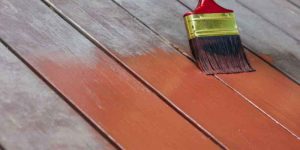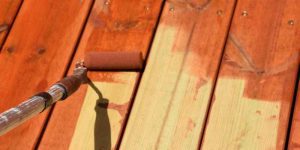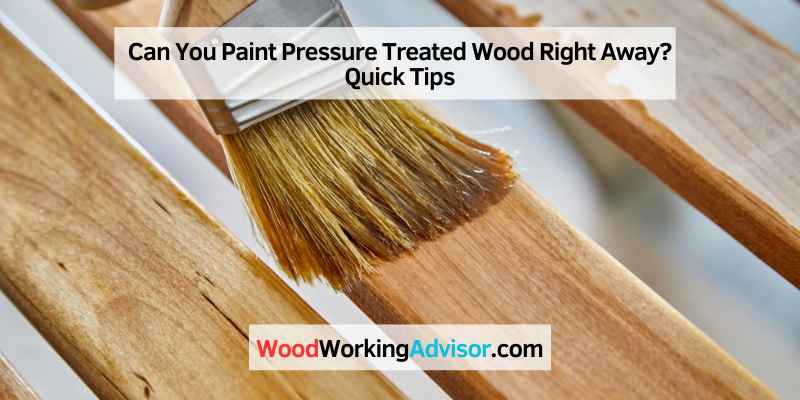You should wait for pressure-treated wood to dry for at least three to four months before painting it. Rushing the process can cause the paint to blister and peel over time.
It’s essential to use the correct type of paint and primer for the best results. Pressure-treated wood is commonly used for outdoor projects due to its resistance to decay and insects. However, many people wonder if they can paint it right away to enhance its appearance and protect it from the elements.
Painting pressure-treated wood too soon can lead to issues such as poor paint adhesion and premature peeling, so it’s crucial to understand the proper timeline for painting this type of wood. We’ll explore the factors that determine when it’s safe to paint pressure-treated wood and provide tips for achieving a successful and long-lasting finish.
Initial Considerations For Painting Pressure Treated Wood
To ensure proper adhesion, it’s best to wait for pressure-treated wood to fully dry before painting. Rushing can result in paint not drying or peeling. Typically, this process takes a few weeks to months, depending on climate and wood type.
It’s advisable to seek professional advice for best results.
When it comes to painting pressure treated wood, there are a few important initial considerations to keep in mind. Understanding the characteristics of pressure treated wood and the importance of proper drying will help ensure a successful paint job and long-lasting results.
Characteristics Of Pressure Treated Wood
Pressure treated wood is treated with chemicals to protect it from rot, decay, and insect damage. This treatment process involves injecting the wood with preservatives, which can impact the paint adhesion if not properly addressed. The high moisture content of pressure treated wood requires specific steps to ensure the paint adheres correctly.
Importance Of Proper Drying
Proper drying is crucial before painting pressure treated wood. The wood needs time to dry out and stabilize after the treatment process. If paint is applied too soon, the excess moisture trapped inside the wood can cause issues such as paint blistering and peeling over time. It is recommended to wait at least three to four months for the wood to dry thoroughly before applying paint.
During the drying period, the wood absorbs water on the surface, indicating it is ready for paint. This ensures that the paint will adhere properly and provide a long-lasting finish. It is essential to use the correct type of paint and primer specifically designed for pressure treated wood to achieve the best results.
By allowing sufficient drying time and using the right products, you can ensure that the paint will stick effectively to the pressure treated wood, resulting in a beautiful and durable finish.
Overall, it is important to consider the characteristics of pressure treated wood and the significance of proper drying before painting. Taking these initial considerations into account will help you achieve a successful and long-lasting paint job on your pressure treated wood surfaces.
The Waiting Game
When it comes to painting pressure treated wood, patience is key. The waiting game refers to the period of time you need to wait before you can paint pressure treated wood. This is because pressure treated wood undergoes a process where chemicals are forced into the wood to make it more resistant to decay and insects. This process leaves the wood with a high moisture content, which needs to dry out before painting. In this blog post, we will explore the typical drying times and factors that can affect the duration of the drying process.
Typical Drying Times
The drying time for pressure treated wood can vary depending on various factors such as climate and the specific type of pressure treated wood. In general, it can take anywhere from a few weeks to several months for the wood to fully dry. This means that you may need to exercise patience before you can proceed with painting.
Factors Affecting Drying Duration
Several factors can affect the duration of the drying process for pressure treated wood. These factors include:
- Climate: The climate plays a significant role in the drying time of pressure treated wood. In areas with high humidity or frequent rainfall, the drying process may take longer.
- Type of Wood: Different types of pressure treated wood may have varying levels of moisture content, which can impact the drying duration.
- Wood Thickness: Thicker pieces of pressure treated wood will take longer to dry compared to thinner ones.
- Ventilation: Proper ventilation can help expedite the drying process by allowing moisture to evaporate more efficiently.
It’s important to note that painting pressure treated wood too soon can have negative consequences. If paint is applied before the wood has fully dried, the paint may not dry properly, leading to blistering and peeling over time. To ensure a successful paint job, it’s always best to wait until the wood has dried out completely.
Now that you understand the waiting game when it comes to painting pressure treated wood, you can plan accordingly and allow the wood to dry before proceeding with your painting project. Patience and proper drying time are essential for achieving a long-lasting and visually appealing result.

Moisture Testing Methods
To ensure proper adhesion, it’s recommended to wait at least three to four months before painting pressure treated wood. This allows the wood to fully dry and be ready for paint application. Using high-quality exterior latex paint is ideal for a durable finish on pressure treated wood surfaces.
Before you paint pressure-treated wood, it is crucial to ensure that the wood is dry enough to hold paint. Moisture in the wood can prevent the paint from adhering properly, leading to blistering, peeling, and other issues. Therefore, it is essential to use moisture testing methods to determine the wood’s moisture content. Here are two commonly used moisture testing methods:
Using a Moisture Meter
A moisture meter is a handy tool that can accurately measure the moisture content of wood. To use it, simply place the pins of the moisture meter on the wood’s surface and read the moisture level on the meter’s display. The ideal moisture level for painting pressure-treated wood is below 15%. If the moisture level is higher, you should wait for the wood to dry out before painting.
The Water Droplet Test
The water droplet test is another simple but effective way to check the wood’s moisture content. To perform this test, sprinkle a few drops of water on the wood’s surface and observe how the water droplets behave. If the water droplets are absorbed into the wood within a few minutes, the wood is dry enough to paint. However, if the water droplets bead up on the surface, the wood is still too wet and needs more time to dry.
In conclusion, moisture testing methods are crucial for determining the moisture content of pressure-treated wood before painting. By using a moisture meter or the water droplet test, you can ensure that the wood is dry enough to hold paint and avoid any issues with paint adhesion.
Preparation Steps Before Painting
Before painting pressure treated wood, it’s crucial to wait for it to dry completely. This process typically takes three to four months, depending on the climate and type of wood. Using high-quality exterior latex paint is recommended for the best results.
Surface Cleaning
Before painting pressure-treated wood, ensure the surface is clean and free of any dirt, dust, or debris. Use a mild detergent and water solution to wash the wood thoroughly. Rinse off the cleaning solution and allow the wood to dry completely.
Sanding And Priming
Next, sand the surface of the pressure-treated wood to smooth out any rough areas or splinters. Use a fine-grit sandpaper to achieve a smooth finish. After sanding, apply a high-quality exterior latex primer to the wood. This will help the paint adhere better and provide a more durable finish.
Choosing The Right Paint And Primer
When it comes to painting pressure treated wood, choosing the right paint and primer is crucial for achieving a long-lasting and beautiful finish. In this section, we will discuss the best types of paint for pressure treated wood and the importance of using a high-quality primer.
Best Types Of Paint For Pressure Treated Wood
When selecting paint for pressure treated wood, it is essential to choose a high-quality exterior latex paint. This type of paint is water-based, allowing it to adhere well to the wood’s surface. Additionally, exterior latex paint is durable and resistant to cracking, peeling, and fading, making it perfect for withstanding the elements.
When it comes to color options, the sky’s the limit! Don’t be afraid to dream big and select a paint color that complements your outdoor space. Whether you prefer a classic neutral shade or a bold and vibrant hue, exterior latex paint can bring your vision to life.
Importance Of High-quality Primer
While it is possible to paint pressure treated wood directly, applying a high-quality primer is highly recommended. Priming the wood before painting serves two essential purposes: increasing paint absorption and enhancing the longevity of the wood.
A primer creates a barrier between the wood and the paint, allowing the paint to adhere better to the surface. This improves the overall coverage and ensures a smoother and more even finish. Furthermore, using a primer helps to seal the wood, preventing moisture from penetrating and causing damage over time.
When selecting a primer for pressure treated wood, look for a product specifically designed for exterior use. These primers are formulated to withstand outdoor conditions and provide optimal adhesion and protection.
In conclusion, when painting pressure treated wood, it is crucial to choose the right paint and primer. Opt for high-quality exterior latex paint for its durability and resistance to fading. Additionally, using a primer will enhance paint absorption and protect the wood from moisture damage. By selecting the appropriate paint and primer, you can ensure a beautiful and long-lasting finish for your pressure treated wood projects.
Application Techniques
When it comes to painting pressure treated wood, the right application techniques can make all the difference in achieving a professional and long-lasting finish. Let’s explore the best practices for applying paint to pressure treated wood to ensure optimal results.
Brush Vs. Spray Application
When deciding on the application method for painting pressure treated wood, you may consider whether to use a brush or a spray. Brush application allows for better control and precision, especially when working on intricate details or smaller areas. On the other hand, spray application can be more efficient for covering larger surfaces and achieving a more even coat of paint. Ultimately, the choice between brush and spray application depends on the specific project requirements and personal preference.
Applying Multiple Coats
Applying multiple coats of paint to pressure treated wood can enhance its durability and aesthetic appeal. Before adding additional coats, it’s crucial to ensure that each previous coat has thoroughly dried. This helps to prevent issues such as uneven coverage or peeling. When applying multiple coats, make sure to follow the manufacturer’s recommendations for drying times and apply each coat evenly to achieve a smooth and uniform finish.
Common Mistakes To Avoid
When it comes to painting pressure treated wood, it’s important to wait for the wood to fully dry before applying any paint. If you paint too soon, the paint may not dry properly and could blister or peel over time.
It’s best to consult with a professional to determine the appropriate waiting time for your specific type of pressure treated wood.
Painting Without Priming
Avoid painting pressure treated wood without priming it first. Priming helps the paint adhere properly and enhances durability. Choose a high-quality primer suitable for pressure treated wood.
Ignoring Weather Conditions
Do not ignore weather conditions when painting pressure treated wood. Extreme temperatures or high humidity can affect the paint’s drying process and adhesion. Ensure you paint on a dry, mild day for optimal results.
Maintenance And Longevity
Pressure-treated wood is a popular choice for outdoor projects due to its durability and resistance to rot and insects. Proper maintenance is key to extending the lifespan of pressure-treated wood and keeping it looking its best.
Routine Maintenance Tips
- Regularly clean the wood surface with a mild soap and water solution.
- Inspect for any signs of damage or wear, such as cracks or splinters.
- Apply a fresh coat of water-repellent sealant every 1-2 years.
When To Repaint Or Touch-up
- Monitor the paint or stain for signs of fading or peeling.
- Touch up any areas with visible wear to prevent moisture penetration.
- Consider repainting the entire surface every 3-5 years for optimal protection.

Frequently Asked Questions
What Happens If You Paint Treated Wood Too Soon?
Painting treated wood too soon can cause the paint to not dry properly, leading to blistering and peeling. Allow the wood to fully dry before painting.
How Long Should You Wait Before Painting Pressure Treated Wood?
It is important to let pressure treated wood dry completely before painting it. The process can take anywhere from a few weeks to several months, depending on the climate and type of wood. It is recommended to wait three to four months before painting.
Using high-quality exterior latex paint is best for pressure treated wood.
What Paint Will Stick To Pressure Treated Wood?
The best paint to use for pressure-treated wood is high-quality exterior latex paint. Avoid using oil-based paints as they may not adhere well. It is important to wait for the wood to fully dry before painting, which can take three to four months.
Applying a primer before painting can also help improve the longevity of the paint job.
How Long Should Pressure Treated Wood Dry Before Using?
To ensure the best results, it is recommended to wait for pressure-treated wood to dry before using or painting it. This process can take anywhere from a few weeks to several months, depending on the climate and the type of pressure-treated wood.
Applying paint too soon may prevent it from drying properly or cause blistering and peeling over time. It is always best to consult a professional for specific advice.
Conclusion
It’s crucial to wait for pressure-treated wood to dry thoroughly before painting. Rushing the process can lead to paint blistering and peeling. It’s best to use high-quality exterior latex paint and allow the wood to dry for at least three to four months.
Consulting a professional is advisable for the best results.

